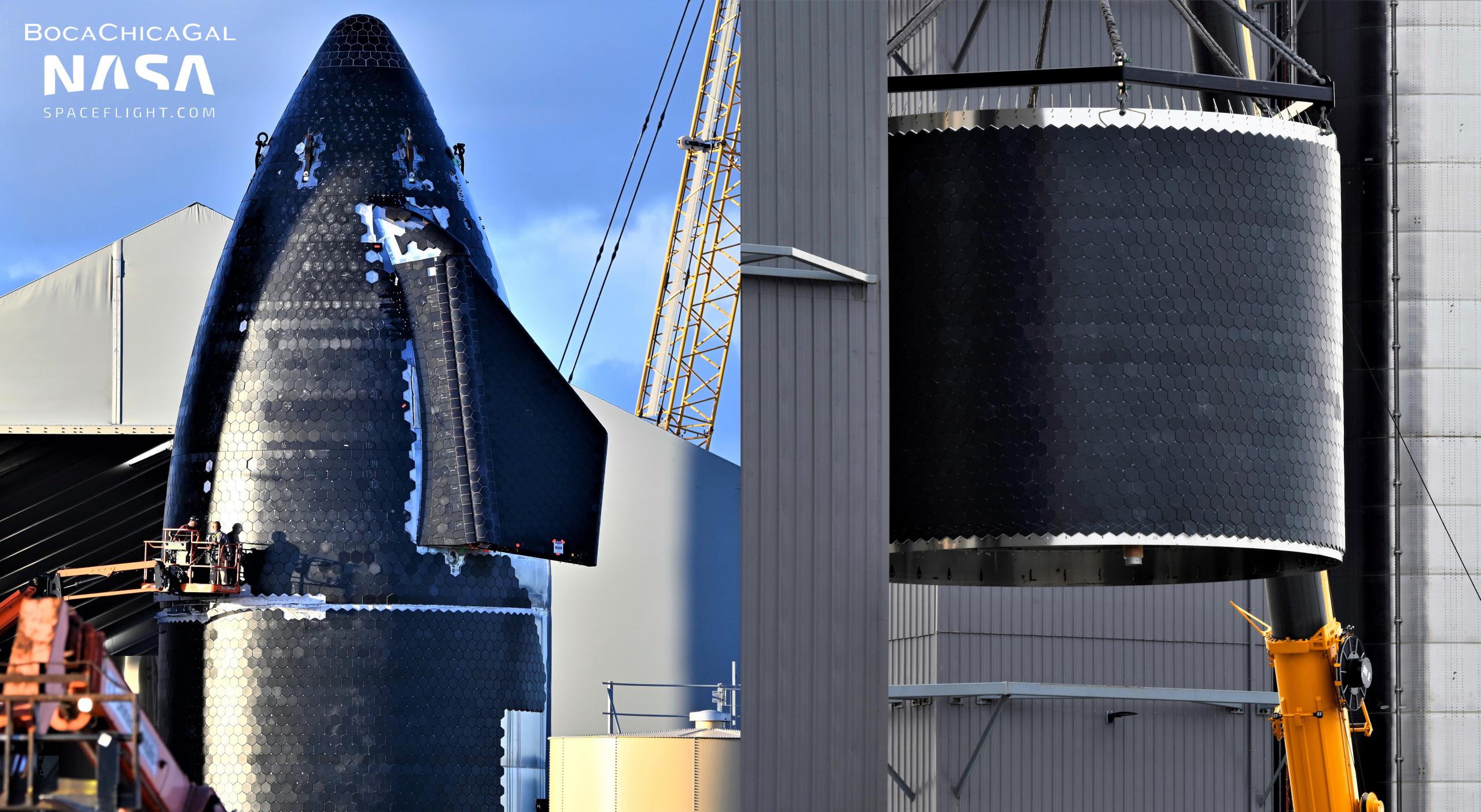
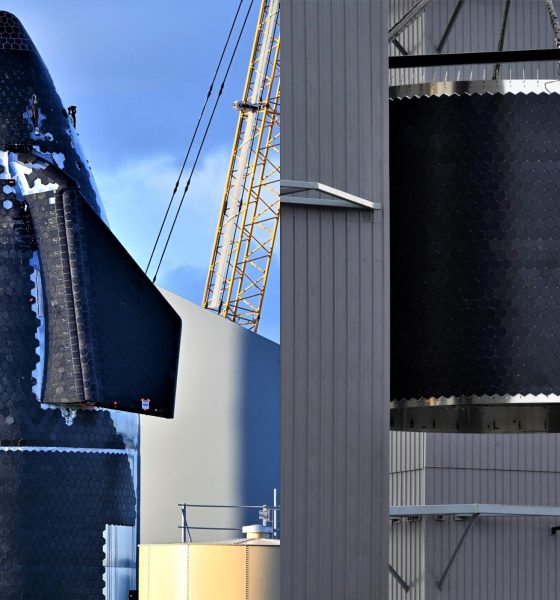
News
SpaceX stacking two Starships at once for the first time in ten months
As of late November, SpaceX has begun stacking two Starship prototypes simultaneously for the first time in ten months.
Known as Starship S21 and S22, SpaceX began stacking the latter prototype inside Starbase’s ‘midbay’ in mid-October – the first Starship assembly work seen in more than two and a half months. For about half a year, SpaceX has been significantly more focused on Super Heavy production as it works to thoroughly test a booster for the first time. In the interim, the assembly of Starships – which already have an impressive history of ground and flight tests – slowed to a halt, though the production of Starship parts did not.
SpaceX builds Starships by forming structures and rings out of rolls, sheets, and billets of steel. For noses, domes, and header tanks, laser or waterjet-cut steel ‘gores’ (a bit like pizza slices) are welded together. Rolls of sheet metal are unspooled, cut into sections, and welded into individual rings that are then stacked on top of each other and robotically welded together around their circumference. Those ring sections – 9m (30 ft) wide and ranging from 2-4 rings tall (3.6-7.3m or 12-24 ft) – are then outfitted with stiffener rings and stringers to add rigidity and strength.
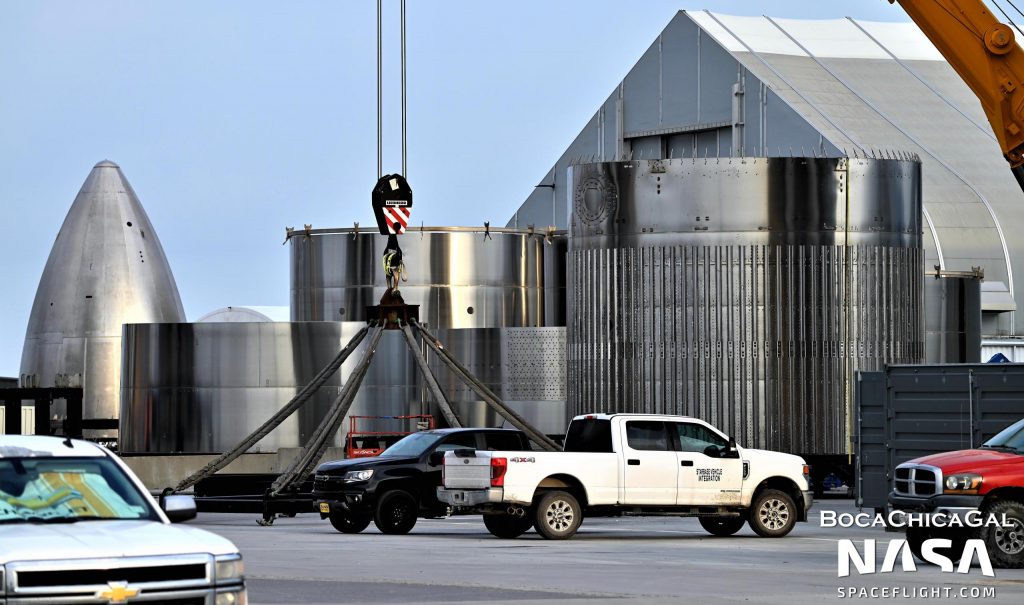
Once that basic structure is complete, parts are cut out or welded on to create structural supports, pass-throughs, and mounts for avionics (batteries, wiring, power, comms) hardware, plumbing, mechanical systems, and more. In the case of ships, robotic arms also weld on thousand of studs that eventually become anchors for heat shield tiles. At some point, certain partially-finished ring sections are ‘sleeved’ around tank domes, of which Starship and Super Heavy both have three. Finally, at some point in the early ‘life’ of a Starship or Super Heavy, SpaceX begins assembling the actual vehicle out of that collection of different sections. While weeks or even months of work always precede that milestone, the first stack is still the point at which SpaceX decides to turn those parts into an actual vehicle – never a guarantee, no matter how far along those parts appear to be.
pic.twitter.com/R7pwD9b30P— RGV Aerial Photography (@RGVaerialphotos) December 2, 2021
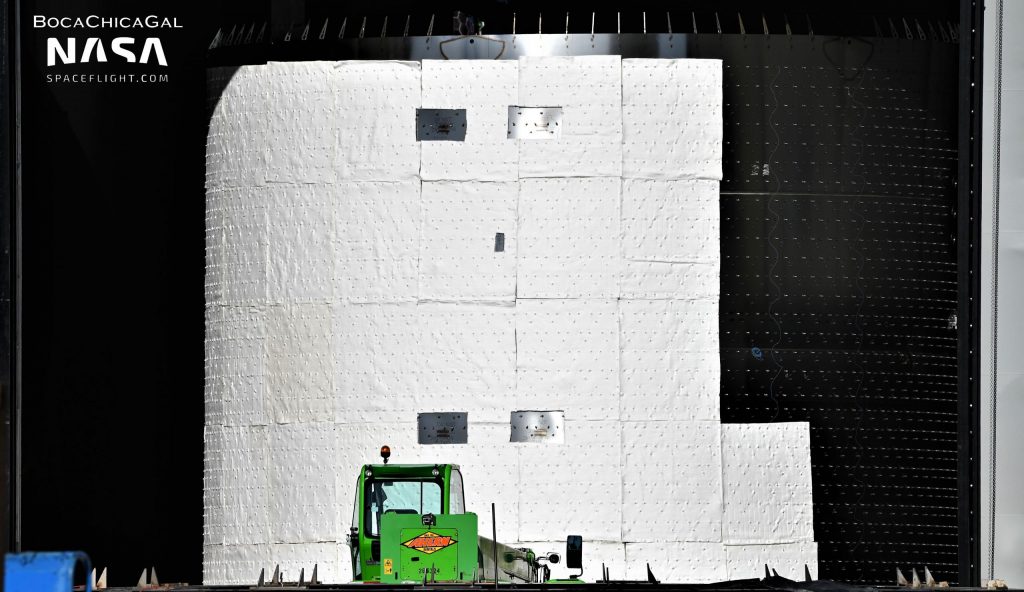
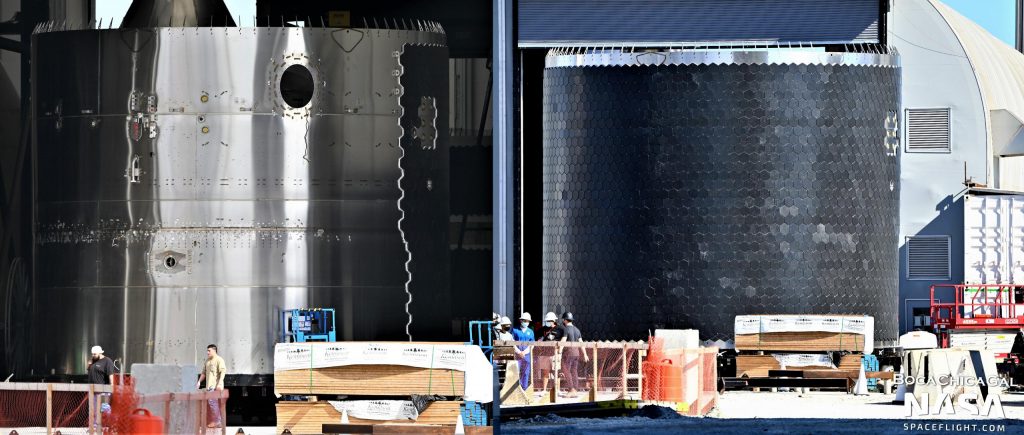
That’s where Starship S21 and Starship S22 found themselves around October 17th and November 21st. Six weeks later, now side by side in Starbase’s midbay, Ship 21’s tank section is fully stacked and Ship 22’s tank section is close to two-thirds complete. Ship 22’s nose assembly – a nosecone and section of four rings – is still in two pieces, while Ship 21’s nose is fully integrated – heat shield included.
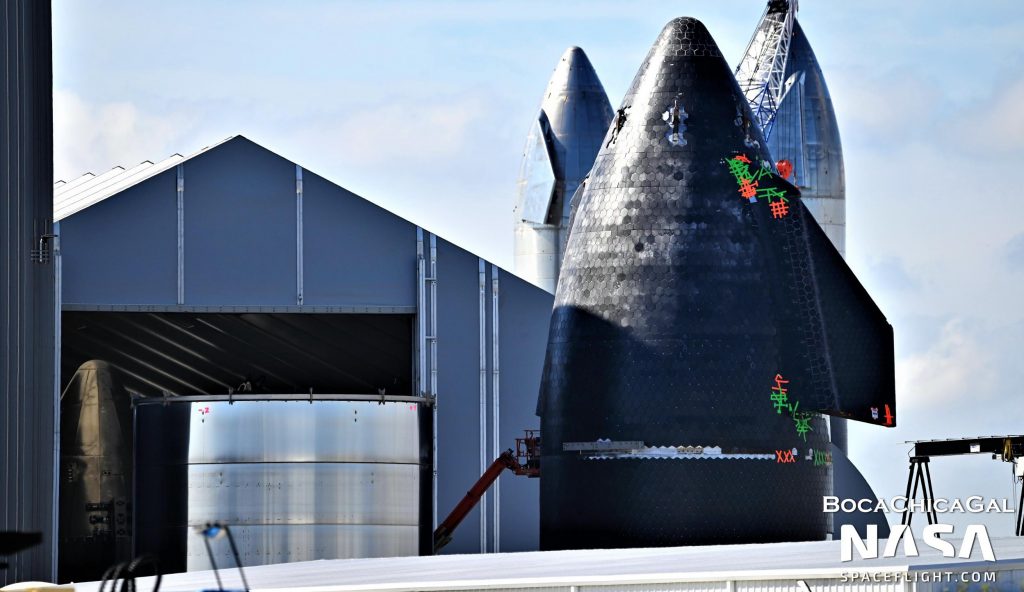
In the very near future, Starship S21’s tank section will be rolled from midbay to high bay for nose installation and Starship S22’s tank section will be topped off with its engine section and leg skirt. Perhaps as early as January, both ships could be fully stacked and more or less waiting in line for qualification testing ahead of Starship’s first few orbital launch attempts. Meanwhile, SpaceX is simultaneously preparing sections of Starship S23 and Super Heavy boosters B6 and B7 for possible assembly late this year or early next.

News
Ford cancels all-electric F-150 Lightning, announces $19.5 billion in charges
“Rather than spending billions more on large EVs that now have no path to profitability, we are allocating that money into higher returning areas, more trucks and van hybrids, extended range electric vehicles, affordable EVs, and entirely new opportunities like energy storage.”
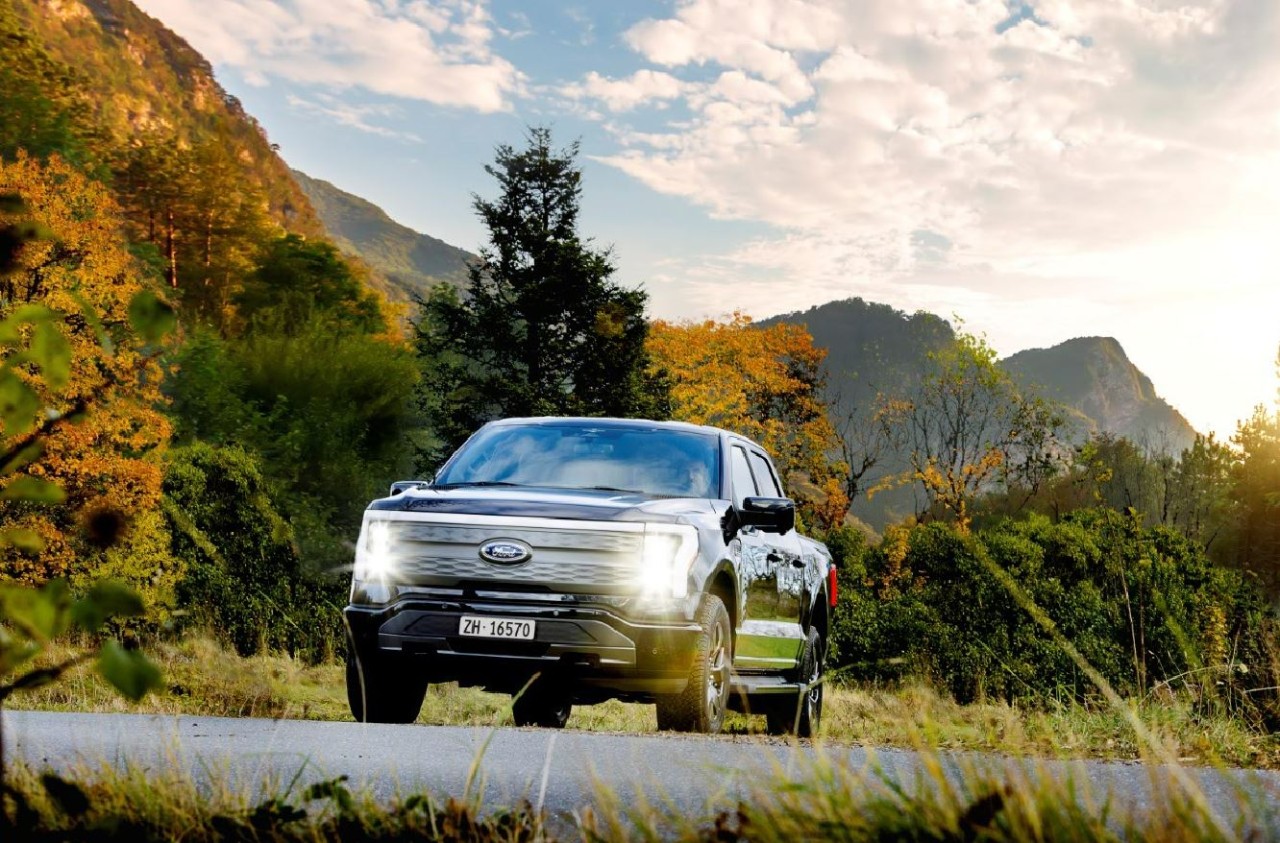
Ford is canceling the all-electric F-150 Lightning and also announced it would take a $19.5 billion charge as it aims to quickly restructure its strategy regarding electrification efforts, a massive blow for the Detroit-based company that was once one of the most gung-ho on transitioning to EVs.
The announcement comes as the writing on the wall seemed to get bolder and more identifiable. Ford was bleeding money in EVs and, although it had a lot of success with the all-electric Lightning, it is aiming to push its efforts elsewhere.
It will also restructure its entire strategy on EVs, and the Lightning is not the only vehicle getting the boot. The T3 pickup, a long-awaited vehicle that was developed in part of a skunkworks program, is also no longer in the company’s plans.
Instead of continuing on with its large EVs, it will now shift its focus to hybrids and “extended-range EVs,” which will have an onboard gasoline engine to increase traveling distance, according to the Wall Street Journal.
“Ford no longer plans to produce select larger electric vehicles where the business case has eroded due to lower-than-expected demand, high costs, and regulatory changes,” the company said in a statement.
🚨 Ford has announced it is discontinuing production of the F-150 Lightning, as it plans to report a charge of $19.5 billion in special items.
The Lightning will still be produced, but instead with a gas generator that will give it over 700 miles of range.
“Ford no longer… pic.twitter.com/ZttZ66SDHL
— TESLARATI (@Teslarati) December 15, 2025
While unfortunate, especially because the Lightning was a fantastic electric truck, Ford is ultimately a business, and a business needs to make money.
Ford has lost $13 billion on its EV business since 2023, and company executives are more than aware that they gave it plenty of time to flourish.
Andrew Frick, President of Ford, said:
“Rather than spending billions more on large EVs that now have no path to profitability, we are allocating that money into higher returning areas, more trucks and van hybrids, extended range electric vehicles, affordable EVs, and entirely new opportunities like energy storage.”
CEO Jim Farley also commented on the decision:
“Instead of plowing billions into the future knowing these large EVs will never make money, we are pivoting.”
Farley also said that the company now knows enough about the U.S. market “where we have a lot more certainty in this second inning.”
News
SpaceX shades airline for seeking contract with Amazon’s Starlink rival

SpaceX employees, including its CEO Elon Musk, shaded American Airlines on social media this past weekend due to the company’s reported talks with Amazon’s Starlink rival, Leo.
Starlink has been adopted by several airlines, including United Airlines, Qatar Airways, Hawaiian Airlines, WestJet, Air France, airBaltic, and others. It has gained notoriety as an extremely solid, dependable, and reliable option for airline travel, as traditional options frequently cause users to lose connection to the internet.
Many airlines have made the switch, while others continue to mull the options available to them. American Airlines is one of them.
A report from Bloomberg indicates the airline is thinking of going with a Starlink rival owned by Amazon, called Leo. It was previously referred to as Project Kuiper.
American CEO Robert Isom said (via Bloomberg):
“While there’s Starlink, there are other low-Earth-orbit satellite opportunities that we can look at. We’re making sure that American is going to have what our customers need.”
Isom also said American has been in touch with Amazon about installing Leo on its aircraft, but he would not reveal the status of any discussions with the company.
The report caught the attention of Michael Nicolls, the Vice President of Starlink Engineering at SpaceX, who said:
“Only fly on airlines with good connectivity… and only one source of good connectivity at the moment…”
CEO Elon Musk replied to Nicolls by stating that American Airlines risks losing “a lot of customers if their connectivity solution fails.”
American Airlines will lose a lot of customers if their connectivity solution fails
— Elon Musk (@elonmusk) December 14, 2025
There are over 8,000 Starlink satellites in orbit currently, offering internet coverage in over 150 countries and territories globally. SpaceX expands its array of satellites nearly every week with launches from California and Florida, aiming to offer internet access to everyone across the globe.
Currently, the company is focusing on expanding into new markets, such as Africa and Asia.
News
Tesla Model Y Standard stuns in new range test, besting its Premium siblings
Tesla’s newer vehicles have continued to meet or exceed their EPA estimates. This is a drastic change, as every 2018-2023 model year Tesla that Edmunds assessed did not meet its range estimates.

The Tesla Model Y Standard stunned in a new range test performed by automotive media outlet Edmunds, besting all of its Premium siblings that are more expensive and more luxurious in terms of features.
Testing showed the Model Y Standard exceeded its EPA-estimated range rating of 321 miles, as Edmunds said it is the “longest-range Model Y that we’ve ever put on our loop.” In the past, some vehicles have come up short in comparison with EPA ranges; for example, the Model Y’s previous generation vehicle had an EPA-estimated range of 330 miles, but only drove 310.
Additionally, the Launch Series Model Y, the first configuration to be built in the “Juniper” program, landed perfectly on the EPA’s range estimates at 327 miles.
It was also more efficient than Premium offerings, as it utilized just 22.8 kWh to go 100 miles. The Launch Series used 26.8 kWh to travel the same distance.
It is tested using Edmunds’ traditional EV range testing procedure, which follows a strict route of 60 percent city and 40 percent highway driving. The average speed throughout the trip is 40 MPH, and the car is required to stay within 5 MPH of all posted speed limits.
Each car is also put in its most efficient drive setting, and the climate is kept on auto at 72 degrees.
“All of this most accurately represents the real-world driving that owners do day to day,” the publication says.
With this procedure, testing is as consistent as it can get. Of course, there are other factors, like temperature and traffic density. However, one thing is important to note: Tesla’s newer vehicles have continued to meet or exceed their EPA estimates. This is a drastic change, as every 2018-2023 model year Tesla that Edmunds assessed did not meet its range estimates.
Tesla Model Y Standard vs. Tesla Model Y Premium
Tesla’s two Model Y levels both offer a great option for whichever fits your budget. However, when you sit in both cars, you will notice distinct differences between them.
The Premium definitely has a more luxurious feel, while the Standard is stripped of many of the more premium features, like Vegan Leather Interior, acoustic-lined glass, and a better sound system.
You can read our full review of the Model Y Standard below:
Tesla Model Y Standard Full Review: Is it worth the lower price?








